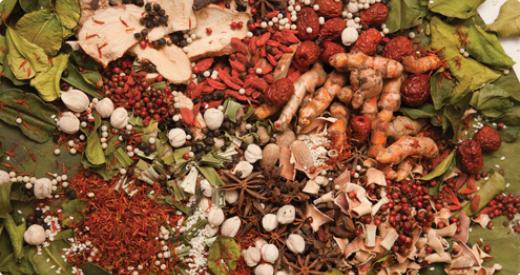
We list out some of the most common herbs and spices used in Asian cuisine.
When it comes to herbs and spices, Asian countries are blessed with an abundant amount of condiments that gives its cuisines exotic flavours and taste. Now, we introduce some of the most common and aromatic ingredients used in different Asian countries, to offer our readers a glimpse of all the different flavours in which Asian cuisine has to offer.
India – Turmeric
Turmeric, also know as haridra or haldi in India, is one of the key ingredients for many Indian dishes, especially for curries. The most common use of turmeric is when they are boiled, oven-dried and grounded into a deep orange-yellow powder to be used as a spice in curry dishes. Fresh turmeric leaves can also be used to wrap and cook food in order to give out a distinctive flavour and colour to the dish. Belonging to the ginger family, it is mildly aromatic with scents of orange or ginger and has a pungent, bitter flavour.
Malaysia – Pandan Leaves
Pandan leaves is a tropical plant with long green leaves that are is frequently found in Southeast Asia and used in Malaysian cuisines. It can be used to wrap savoury foods items, such as chicken and its paste is often used in cakes and desserts to give them it a unique bright green colour and a sweet taste, while also giving off an aroma which is similar to a the scent of coconut.
Indonesia – Tamarind
In
Indonesia, tamarind also is given the name of asam with regards to its sweet and sour taste. The dried tamarind leaves are used with lentils to fish curries and masalas to give it a mild flavour to add to fish curries and masalas for flavouring. Meanwhile, its fruit is often made into desserts and jam or blended into juices or sweetened drinks, sorbets, ice creams and all sorts of snacks. Apart from having great importance in Indonesian cuisine, the pulp of the tamarind is also a vital ingredient in HP sauce and Worcestershire sauce.
Thailand – Thai Basil
Unlike Italian basil, Thai basil possesses a more pronounced liquorice flavour. Thai basil also has a stronger scent and tends to holds it flavour better when it is cooked as compared to the sweet basil which has with a peppery taste. It The Thai basil is often used in iconic Thai dishes such as Thai drunken noodles and cooked with chicken, pork and seafood. The flowers of the plant, which are also edible, make an attractive plate garnish or colourful addition to green salads.
Philippines – Lemongrass
Lemongrass, also referred to as tanglad, is a very popular ingredient in the Philippines, used in dishes as well as herbal teas and soaps. Slightly sweet with a hint of citrus, the leaves and the bases of the plant are commonly used as food flavouring in seafood and poultry dishes, and its essential oils are used medicinally to aid digestion, reduce stomach problems and fevers. Its distinctive flavours balances the spiciness in chilli dishes and can also be found in an array of Asian cuisines.
Japan – Shiso
Originally cultivated for its oil in Japan, shiso’s culinary use is now ubiquitous in Japanese cooking. Available in green, red and a combination of both shades, the attractive and aromatic leaves give a flavour combination resembling a combination of basil and mint. Red leaves are commonly used to flavour and colour pickles, while the green ones are used for garnishing and seen in tempura. Shiso leaves can be eaten raw, cooked or even pickled. The attractive purple shiso flower is also sometimes used as a garnish, but they can also be eaten, lending a sweeter and more subtle flavour to dishes such as sashimi.
By Cindy Chan
Reposted with permission from Asia Tatler Dining









